Ingredients
You need just a handful of basic ingredients to create these delicious homemade bagels. Most items are likely already in your pantry right now.
For the Bagel Dough
- 3 cups bread flour
- 1 tablespoon granulated sugar
- 2 teaspoons active dry yeast
- 1 teaspoon salt
- 1 cup warm water (110°F)
- 2 tablespoons vegetable oil
For Boiling
- 8 cups water
- 2 tablespoons granulated sugar
For Topping (Optional)
- 1 large egg beaten with 1 tablespoon water (egg wash)
- Everything bagel seasoning
- Sesame seeds
- Poppy seeds
- Coarse sea salt
- Dried garlic flakes
- Dried onion flakes
Equipment Needed
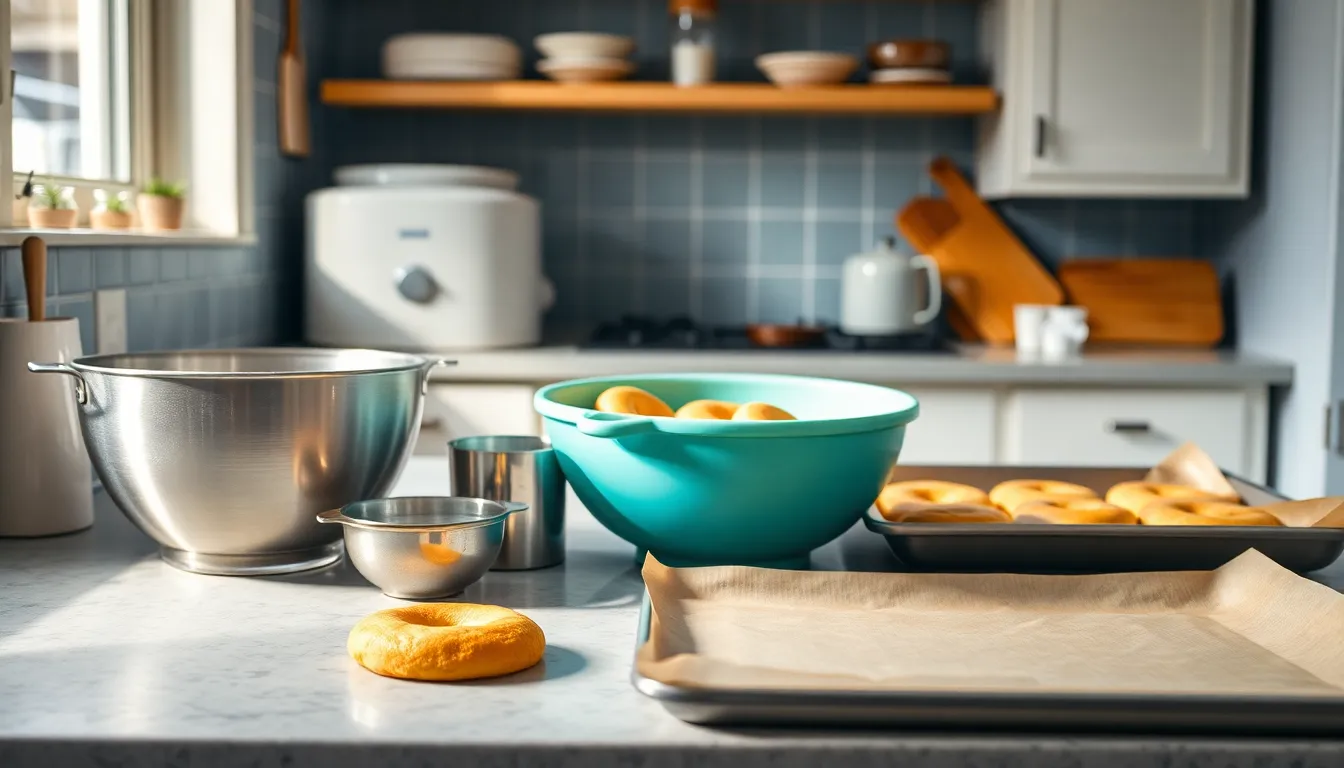
Making homemade bagels requires minimal kitchen equipment that most home bakers already own. You can create perfectly chewy bagels without investing in specialized tools or gadgets.
Essential Equipment:
- Large mixing bowl for combining dough ingredients
- Kitchen scale or measuring cups for accurate ingredient portions
- Clean kitchen towel for covering rising dough
- Large stockpot or Dutch oven for boiling bagels
- Slotted spoon for transferring bagels safely
- Baking sheet lined with parchment paper
- Wire cooling rack for proper bagel cooling
Optional but Helpful Tools:
- Stand mixer with dough hook attachment for easier kneading
- Kitchen thermometer to check water temperature
- Pastry brush for applying egg wash
- Bench scraper for dividing dough portions
Your mixing bowl should accommodate the dough as it doubles in size during the first rise. The stockpot needs enough capacity to hold 8 cups of water plus room for bagels to float freely without overcrowding.
A slotted spoon prevents burns when moving hot bagels from boiling water to the baking sheet. Parchment paper eliminates sticking and makes cleanup effortless after baking.
Standard measuring tools work perfectly for this recipe, though a kitchen scale provides more consistent results. The wire cooling rack allows air circulation around freshly baked bagels, preventing soggy bottoms while maintaining that signature chewy texture.
Instructions
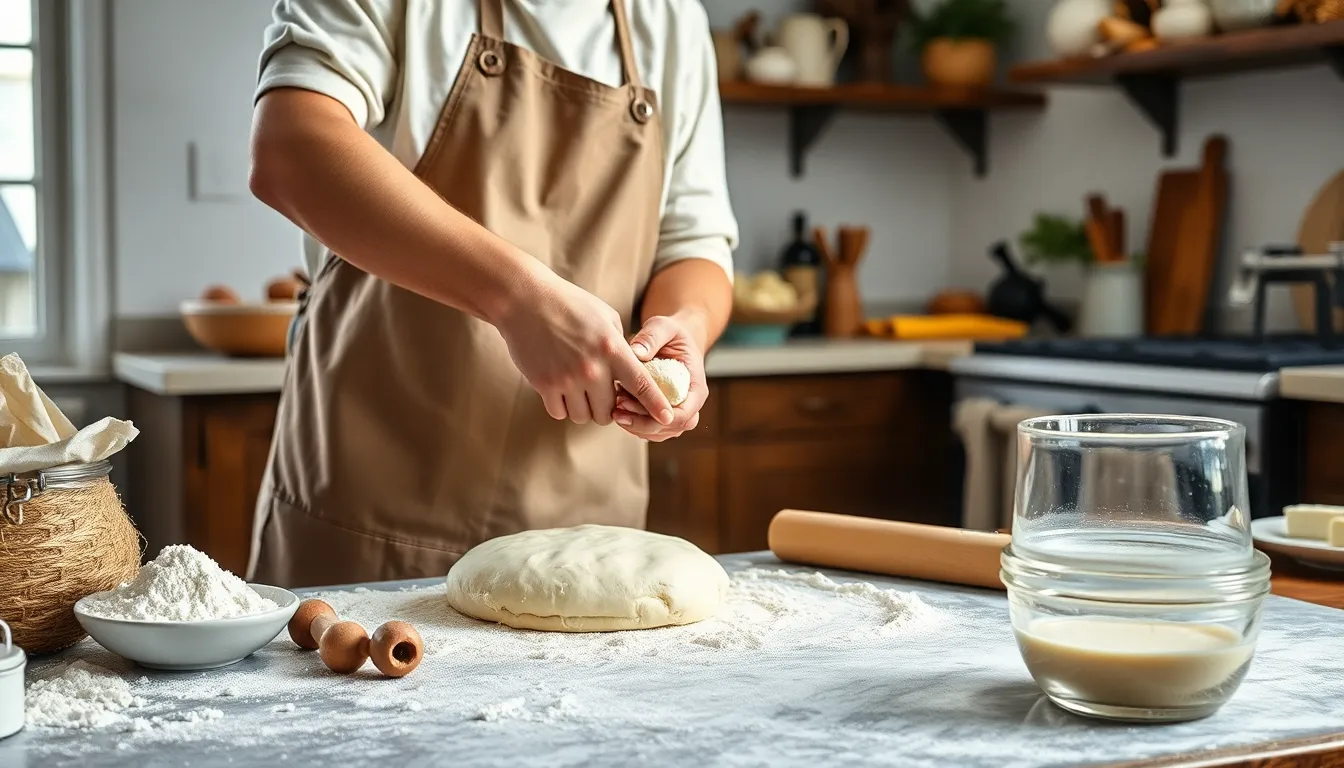
Creating perfect homemade bagels requires careful attention to timing and technique throughout each step. Follow these detailed instructions to transform your basic ingredients into bakery-quality bagels.
Prep the Dough
Combine the bread flour, granulated sugar, active dry yeast, and salt in your large mixing bowl. Whisk the dry ingredients together until evenly distributed. Create a well in the center of the flour mixture and pour in the warm water and vegetable oil. Stir the mixture with a wooden spoon or spatula until a shaggy dough forms.
Turn the dough onto a lightly floured surface and knead for 8-10 minutes until the dough becomes smooth and elastic. The dough should spring back when gently pressed with your finger. Add small amounts of flour if the dough feels too sticky, but avoid adding too much as this will make your bagels dense. Place the kneaded dough in a lightly oiled bowl and turn to coat all sides.
First Rise
Cover the bowl with your clean kitchen towel and place in a warm, draft-free location. Allow the dough to rise for 60-90 minutes until it doubles in size. The ideal temperature for rising is between 75-80°F. You can test if the dough has risen sufficiently by gently pressing two fingers into the surface – the indentations should remain and not spring back immediately.
Shape the Bagels
Punch down the risen dough to release air bubbles and turn it onto a lightly floured surface. Divide the dough into 8 equal portions using a bench scraper or sharp knife. Roll each portion into a smooth ball by tucking the edges underneath.
To form the classic bagel shape, poke your thumb through the center of each ball and gently stretch the hole to about 2 inches wide. The hole should be large enough to accommodate shrinkage during boiling and baking. Place the shaped bagels on a parchment-lined baking sheet, spacing them about 2 inches apart.
Second Rise
Cover the shaped bagels with the kitchen towel and let them rise for another 20-30 minutes. The bagels should increase in size by about 50% but should not double completely. This shorter second rise helps maintain the bagels’ characteristic dense texture.
Boil the Bagels
Fill your large stockpot with 8 cups of water and add 2 tablespoons of granulated sugar. Bring the water to a rolling boil over high heat. The sugar helps create the bagels’ signature golden color and slightly sweet flavor.
Carefully lower 2-3 bagels at a time into the boiling water using your slotted spoon. Boil each bagel for 1-2 minutes per side, flipping once. The bagels will puff slightly and develop a glossy surface. Remove the boiled bagels with the slotted spoon and place them back on the parchment-lined baking sheet.
Bake the Bagels
Preheat your oven to 425°F while you finish boiling the remaining bagels. If desired, brush the tops of the bagels with beaten egg wash and sprinkle with your chosen toppings such as everything seasoning, sesame seeds, or coarse salt.
Bake the bagels for 20-25 minutes until they develop a deep golden brown color and sound hollow when tapped on the bottom. The internal temperature should reach 200°F when measured with a kitchen thermometer. Transfer the finished bagels to a wire cooling rack and allow them to cool for at least 15 minutes before slicing.
Make-Ahead Instructions
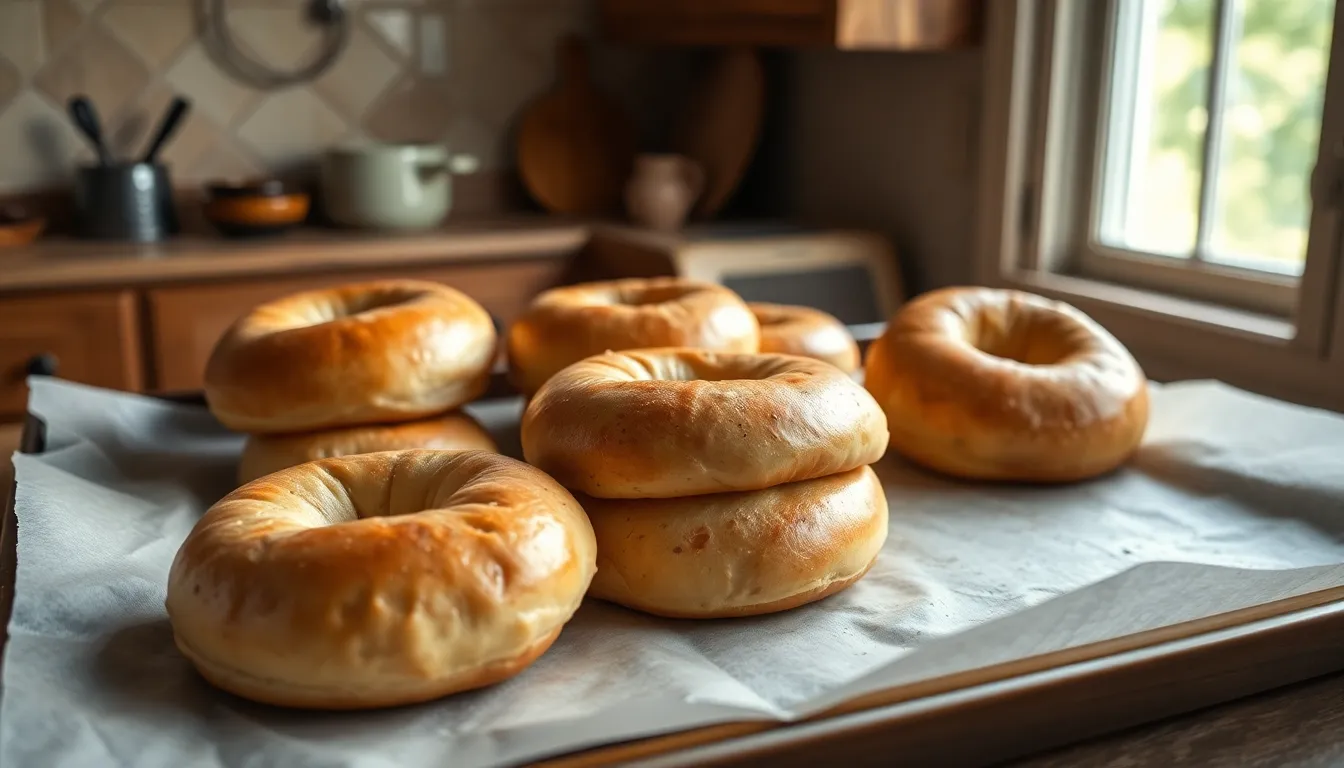
Planning ahead transforms bagel making into a stress-free breakfast solution. You can prepare these homemade bagels entirely up to 24 hours before serving by adjusting the timing of your preparation steps.
Overnight Dough Method: Prepare your bagel dough through the first rise stage. After kneading the dough until smooth and elastic, place it in an oiled bowl and cover tightly with plastic wrap. Refrigerate the dough for up to 24 hours instead of allowing it to rise at room temperature. The cold environment slows fermentation while developing deeper flavors. Remove the chilled dough 30 minutes before shaping to bring it closer to room temperature.
Shape and Refrigerate: Complete the bagel shaping process and arrange your formed bagels on a parchment-lined baking sheet. Cover the shaped bagels loosely with plastic wrap and refrigerate for up to 12 hours. This method allows you to wake up to ready-to-boil bagels that require minimal morning preparation.
Freeze for Future Use: Shaped bagels freeze beautifully for up to 3 months. Place the formed bagels on a baking sheet and freeze until solid (about 2 hours). Transfer frozen bagels to freezer bags with dates marked clearly. Thaw frozen bagels overnight in the refrigerator before proceeding with the boiling and baking steps.
Boiled and Ready: You can boil your bagels the night before and refrigerate them on the baking sheet. Cover the boiled bagels with plastic wrap and bake them fresh the next morning. Add 2-3 extra minutes to the baking time when starting with refrigerated boiled bagels.
Fresh Baked Storage: Completely cooled baked bagels store well at room temperature for 2 days in an airtight container. Freeze baked bagels for up to 3 months and toast them directly from frozen for quick breakfasts.
Storage Tips
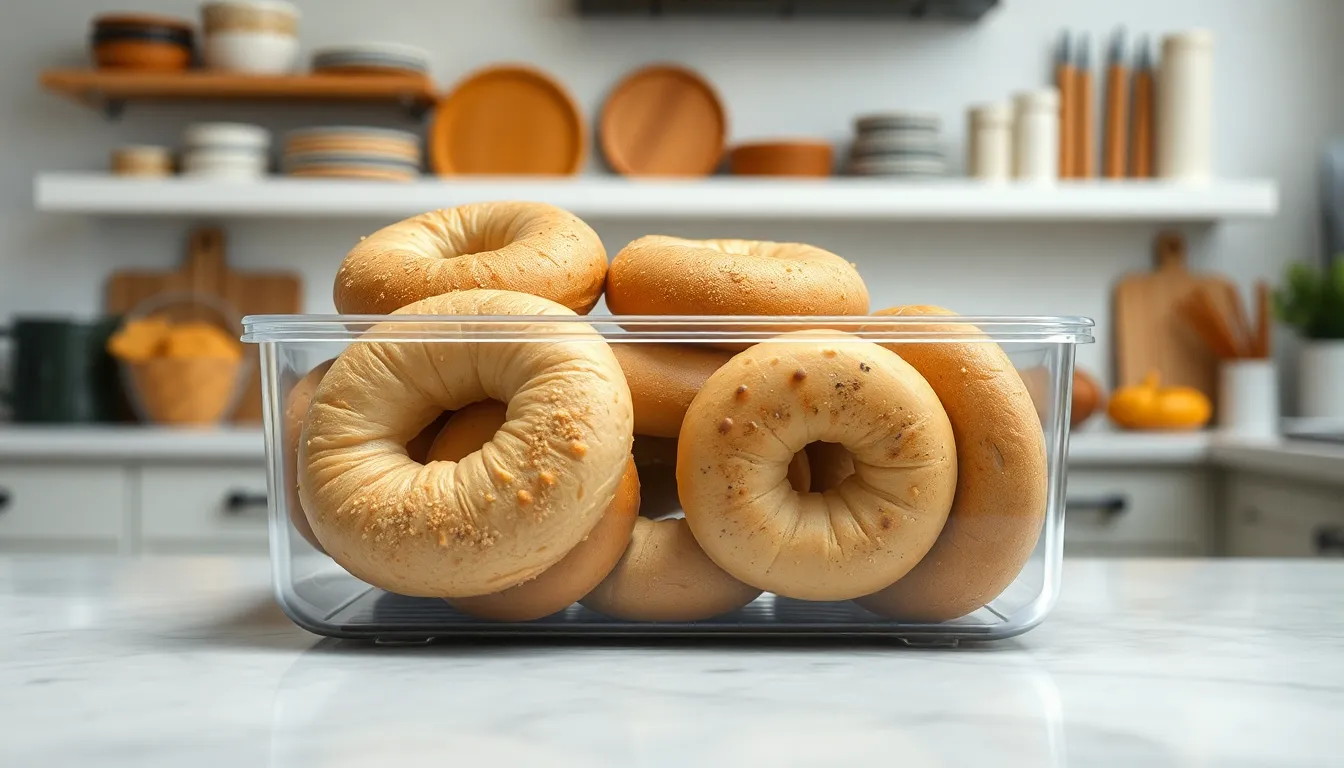
Your freshly baked bagels deserve proper storage to maintain their delicious taste and texture. Store room temperature bagels in an airtight container or sealed plastic bag for up to 3 days on your kitchen counter. Avoid refrigerating fresh bagels as this actually accelerates staling and creates a tough texture.
Freezing offers the best long-term storage solution for your homemade bagels. Wrap each cooled bagel individually in plastic wrap or aluminum foil before placing them in a freezer-safe bag. Remove as much air as possible to prevent freezer burn and maintain quality for up to 3 months.
| Storage Method | Duration | Best Practices |
|---|---|---|
| Room Temperature | 3 days | Airtight container or sealed bag |
| Freezer | 3 months | Individual wrapping + freezer bag |
| Sliced and Frozen | 3 months | Pre-slice before freezing for convenience |
Pre-slicing your bagels before freezing saves time during busy mornings. Cut cooled bagels in half using a sharp serrated knife before wrapping and freezing. This allows you to toast frozen bagel halves directly from the freezer without thawing.
Thaw frozen whole bagels at room temperature for 30-60 minutes or unwrap and microwave for 15-20 seconds. Toast thawed bagels in your toaster or toaster oven to restore their crispy exterior and warm interior. Frozen bagel halves can go straight into the toaster for 2-3 minutes until heated through and lightly golden.
Never store bagels in paper bags for extended periods as they will dry out quickly. Plastic bags work better than containers for maintaining moisture while preventing the bagels from becoming soggy. Check stored bagels regularly and discard any showing signs of mold or off odors.
Topping Variations

Transform your homemade bagels into bakery-worthy creations with these classic topping combinations. Each variation adds unique flavors and textures that elevate your breakfast experience.
Everything Bagels
Everything bagel seasoning creates the most popular bakery-style topping that combines multiple flavors in one irresistible blend. You can purchase pre-made everything seasoning or create your own mixture using equal parts sesame seeds, poppy seeds, dried garlic flakes, dried onion flakes, and coarse sea salt. Brush your shaped bagels with egg wash before adding a generous sprinkle of the seasoning blend. The egg wash helps the toppings adhere during baking and creates a beautiful golden shine. Apply the seasoning immediately after brushing to ensure maximum coverage and proper binding.
Sesame Seed Bagels
Sesame seeds provide a nutty flavor and delightful crunch that makes these bagels a timeless favorite. Toast the sesame seeds in a dry skillet for 2-3 minutes until lightly golden to enhance their flavor before using. Brush your bagels with egg wash and generously sprinkle with toasted sesame seeds, pressing gently to help them stick. White sesame seeds are traditional, but you can experiment with black sesame seeds for a striking visual contrast. The toasted seeds will deepen in color during baking and develop an even richer nutty taste.
Poppy Seed Bagels
Poppy seeds offer a subtle nutty flavor with an appealing speckled appearance that creates an elegant bakery-style finish. These tiny blue-black seeds stick best when applied over egg wash, so brush your shaped bagels thoroughly before sprinkling. Use approximately 1-2 teaspoons of poppy seeds per bagel for optimal coverage without overwhelming the bread’s flavor. Gently press the seeds into the surface to prevent them from falling off during boiling and baking. The seeds will darken slightly during the baking process and provide a pleasant textural contrast to the chewy bagel interior.
Salt Bagels
Coarse sea salt or pretzel salt creates a simple yet sophisticated topping that enhances the bagel’s natural wheat flavor. Choose coarse salt crystals rather than fine table salt to achieve the authentic bakery appearance and proper flavor distribution. Brush your bagels with egg wash and sprinkle with salt immediately before baking, using approximately 1/2 teaspoon per bagel. The larger salt crystals will remain visible after baking and provide bursts of salty flavor with each bite. Avoid over-salting as the crystals will concentrate in flavor during the baking process.
Troubleshooting Tips
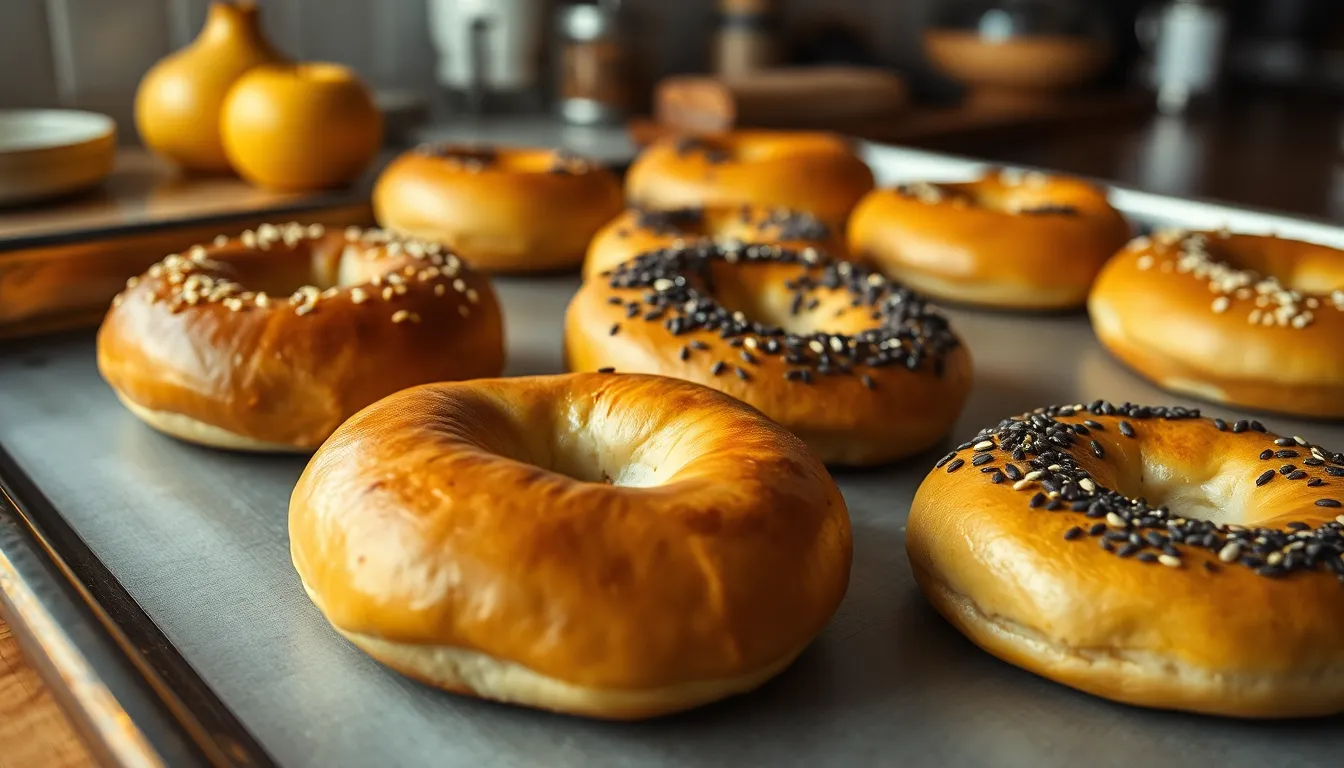
Your bagels didn’t rise properly during the first or second rise, which usually indicates issues with yeast activation or temperature conditions. Check that your yeast hasn’t expired by testing it in warm water with a pinch of sugar before mixing your dough. Water temperature plays a crucial role in yeast activation, so ensure it feels comfortably warm to your wrist rather than hot, which can kill the yeast. Room temperature affects rising time significantly, with cooler environments requiring longer rise periods and warmer spaces speeding up the process.
Dense or heavy bagels often result from using too much flour or insufficient kneading. Measure your flour accurately using the spoon-and-level method rather than scooping directly from the bag, which can pack in excess flour. Knead your dough for the full 8-10 minutes until it becomes smooth and elastic, as proper gluten development creates the chewy texture that defines a perfect bagel. Under-kneaded dough produces dense results that lack the characteristic bagel texture.
Bagels that spread too much during boiling indicate overly soft dough or insufficient second rise. Add small amounts of flour during the initial mixing if your dough feels sticky after the first few minutes of kneading. Allow shaped bagels to rest for the full 20-30 minutes during the second rise, as this helps them hold their shape when they hit the boiling water. Test doneness by gently pressing the bagel surface with your finger; it should spring back slowly when ready for boiling.
Your boiling water lost its rolling boil when you added the bagels, which happens when you add too many at once or use insufficient water. Maintain a vigorous boil by working in small batches of 2-3 bagels maximum and using the full 8 cups of water specified in the recipe. Return the water to a full boil between batches to ensure consistent results and proper crust formation.
Pale or insufficiently golden bagels suggest oven temperature issues or inadequate boiling time. Verify your oven temperature with an oven thermometer, as many home ovens run cooler than their settings indicate. Boil each bagel for the full 1-2 minutes per side to develop the proteins that create the golden-brown crust during baking. Position your baking sheet on the middle rack to ensure even browning and rotate it halfway through baking if your oven has hot spots.
Toppings that fall off during or after baking usually result from insufficient adhesion methods. Apply egg wash immediately after removing bagels from the boiling water while they’re still wet, as this creates the sticky surface needed for toppings to adhere. Press toppings gently into the surface rather than simply sprinkling them on top. Store topped bagels in airtight containers to prevent moisture loss that can cause toppings to become loose and fall off.
Serving Suggestions

Your freshly baked homemade bagels offer endless possibilities for delicious meals and snacks throughout the day. Toast them lightly to enhance their chewy texture and spread cream cheese for the classic bagel experience that never disappoints.
Create gourmet breakfast sandwiches by slicing your everything bagels in half and filling them with scrambled eggs, crispy bacon, and fresh avocado. Layer smoked salmon, capers, red onion, and dill cream cheese on a toasted sesame bagel for an elegant brunch option that rivals any bakery creation.
Transform your plain bagels into sweet treats by toasting them and spreading peanut butter with sliced bananas and a drizzle of honey. Cinnamon sugar bagels pair beautifully with cream cheese mixed with fresh berries for a dessert-like indulgence.
Build hearty lunch sandwiches using your homemade bagels as the foundation for turkey, lettuce, tomato, and your favorite condiments. The dense texture holds ingredients securely while providing satisfying substance that keeps you full longer than regular bread.
Slice day-old bagels into chips and bake them at 350°F for 10-12 minutes to create crunchy bagel chips perfect for dipping in hummus or spinach artichoke dip. These crispy alternatives work wonderfully for parties or as a healthy snack option.
Pizza bagels make excellent quick meals by splitting bagels in half, adding pizza sauce, mozzarella cheese, and your preferred toppings before broiling for 3-4 minutes until bubbly. Kids especially love this creative twist on traditional pizza night.
Serve warm bagels alongside soup or salad for a complete meal that showcases your baking skills while providing comfort food satisfaction. The homemade touch elevates any simple meal into something special that guests will remember and request again.
Conclusion
You’re now equipped with everything you need to transform your kitchen into a bagel bakery. This straightforward recipe proves that professional-quality bagels don’t require professional equipment or years of experience.
Your first batch might not look perfect but don’t let that discourage you. Every baker’s journey starts with simple steps and each attempt brings you closer to mastering this beloved breakfast staple.
The beauty of homemade bagels lies in their endless customization possibilities. Whether you prefer classic everything seasoning or want to experiment with sweet variations you control every ingredient that goes into your creation.
Start your bagel-making adventure today and discover why nothing beats the taste and aroma of fresh bagels straight from your own oven.

